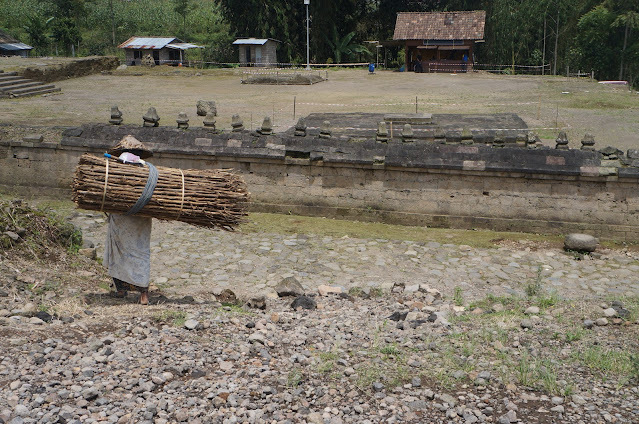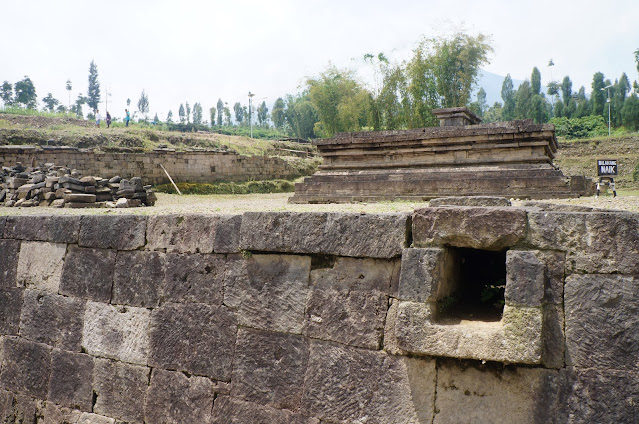(Originally written for my other blog indohoy.com which exists no more, 2016)
I was riding in a cab in the midst of Jakarta skyscraper jungle and suddenly a question popped up in my mind. “What if one day Jakarta becomes a buried city? How long would it take to dig the dirt and uncover all the buildings?” This thought didn’t come out of nowhere. I was looking up the buildings after posting a photo on Instagram from my recent visit to Liyangan, a buried ancient city located in Central Java.
Liyangan, or sometimes spelled Liangan, is barely known by Indonesians. I first heard about it only a few months before our trip, and decided to join the tour because it was going to be guided by an archeologist, Sugeng Riyanto. Pak Sugeng, who is also the head of the Liyangan excavation project, explained so many things about the site, gathered since the project started in 2008. Until November 2016, when we visited, they had excavated a land 3 hectares wide and 7 meters deep. According to Pak Sugeng that is a fast progress. “We’ve got much help from the sand miners who first found the ruins and then helped digging along the way,” he said.
Like other buried cities in the world such as Pompeii and Akrotiri, ruins of a settlement in Liyangan was buried deep underground caused by a big volcano eruption. In Liyangan case, it was the eruption of Mount Sindoro, located only about 8 km away, in the 10th century. It’s concluded that the settlement had existed since centuries before that, older than the Borobudur temple in Magelang.
The Liyangan site used to be a settlement with houses, paddy fields and places of worship. Upon arrival to the site, if you’re coming from the parking lot near the village, you’ll see a sign with the site’s name. Next to it is a candi (temple), with no stairs found (there might not be any stairs ever or perhaps wooden stairs that have been eaten by the weather). Behind it, on a higher level, a smaller candi with four smal platforms called batur.The baturs are predicted to be where rituals started, before finally worshippers reach the candi.
If you’re standing facing the Mount Sindoro and the candis and baturs are on your left, you’ll see a bigger platform on your right. It’s predicted to be a marquee or a pavilion. A few holes on the sides indicate there used to be pillars. And guess what. The excavators found a few big round stones with holes in them, as well as a log of wood with diameter that fits the hole in other parts of the site. I bet it was an aha! moment for the archeologists. The marquee was thought as a place for worship rituals also with no stairs detected.
On my visit, there was another stone building still in excavation process that’s thought as the bathing spot because there are some ‘showerheads’ on the top edges of the thing. It’s not yet known whom it was for.
Separated from the worship area, by a fence and a cobblestone lane, there is a higher level where houses used to be, as concluded for there were found roof materials, cooking wares and potteries, and that there weren’t many building ruins left – it’s predicted that houses were mostly built with wood that was destroyed over time. Some other materials were found and still intact, though have changed in colors and became dry, like the roof fibers and corns! Yes, corn cobs with the leaves! It’s how they were buried so deep within volcanic ashes, pebble rocks and sand that sort of preserved them.
One of the things that I found awesome was how these people centuries ago managed to build things from rocks without using another material to “glue” them together. What they used is hook system. Some stones were carved out so as to have latching part to the others, which made the wall/building strong enough to stand through earthquakes to some extent.
Excavation process is still going on. “We estimate that there’s still 7 meters deep more of this whole civilization,” Pak Sugeng said, referring to the the 7-meter tall wall in front of us, that was also a result of excavation. He also said that his team predicted (or concluded) that Liyangan site had existed before the people had come in touch with Hinduism. It came along with trade with other peoples, which how most religions came to Indonesia. That eventually affected the design modification of some of the buildings.
Buried ancient cities amaze me. It’s hard to imagine there used to be a whole lot of life deep beneath where you walk, sleep, eat and poo (living in a high-rise building doesn’t count because you can still see the life beneath you). And it’s also amazing how archeologists and those involved in the excavation do their magic to find out what used to be centuries ago. It’s being exposed to sites like this that makes me feel small, that what I know is really nothing compared to what’s been done even since centuries or millenniums ago.
















No comments:
Post a Comment